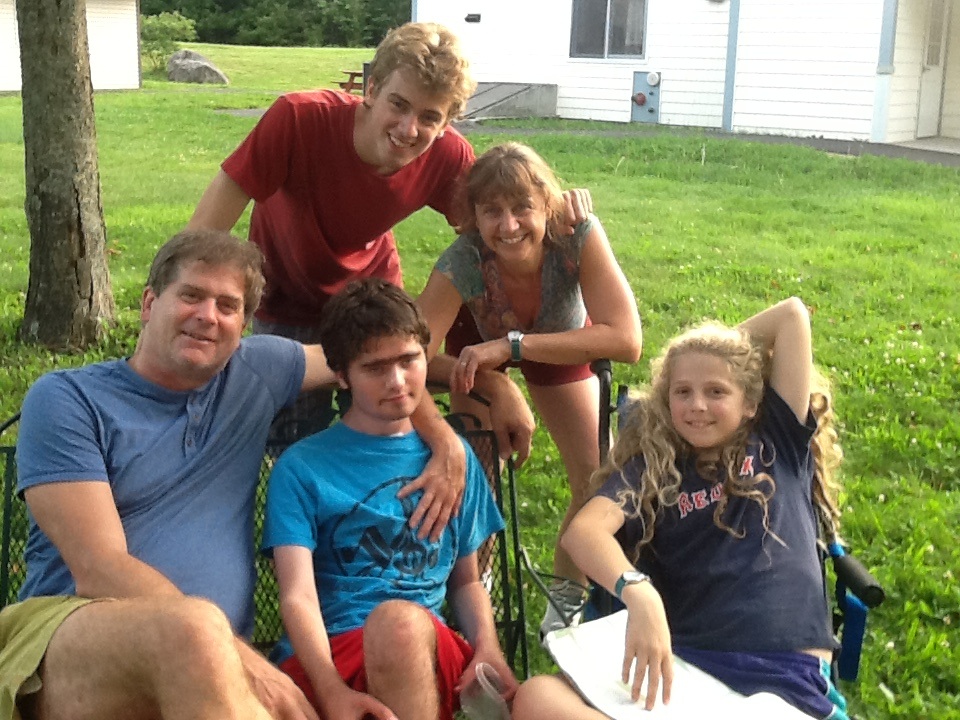
“We don’t know what it is, but it’s something significant.”
When Julie and Alec McKinney heard these words about their infant son, Tyler, it marked the beginning of a journey to identify the root cause of the abnormalities he was born with and also provide him with the best life possible to meet his special needs. Even though there were challenges along the way, they did not face them alone: a team of providers at Boston Medical Center were with them every step.
During a prenatal ultrasound, Alec and Julie received difficult news: their son may be born with complications of an unknown cause, signaled by the presence of one kidney. “When Tyler was born, we knew something was wrong,” Alec says. Their fears confirmed, Tyler’s appearance was described as floppy and weak with multiple congenital defects, including dysmorphic features. Wanting Tyler to receive incomparable care and a diagnosis, the McKinneys knew he would be in the best hands at Boston Medical Center, under the charge of Primary Care Physician Benjamin Siegel, MD. “We’ve always had an incredible amount of respect for the way BMC perceives the importance of families and takes a broad, holistic view of health and coordination of care,” says Alec. “So it was a no brainer to go there for pediatric care.”
Upon first evaluation, Siegel made two key observations: Tyler appeared to have a genetic condition, and he was not developing at a healthy rate. “We determined this was pretty serious,” he recalls. Siegel assembled two teams of clinicians to tackle both issues simultaneously, including Genetics and Neurology. Although this seemed like a novel approach, coordinating integrated care to facilitate a child’s health and well-being has been central to Siegel’s work for more than 40 years, ever since becoming the first pediatrician to practice hospital-based primary care at BMC. “Boston Medical Center is the birthplace of hospital-based primary care. Coordinating an interdisciplinary team is the essence of what we do,” he explains.
The first step in promoting Tyler’s growth and development was to address the one-month-old’s low weight. Tyler was diagnosed with Failure to Thrive, a condition often attributed to malnourishment where growth milestones are not met. He struggled with grasping by mouth, so various feeding methods were explored with the help of a visiting home nurse and a home visit from Dr. Siegel to check in on Tyler’s progress. Ultimately, tube feeding was best, so a permanent tube was inserted through the abdomen, allowing food to be delivered directly to the stomach. In addition, Siegel attended to other symptoms that risked Tyler’s development, including seizures and visual impairment. The family was referred to Early Intervention (EI), which helps families recognize and understand their child’s particular developmental needs, and learn different ways to help their child. “We had been wondering what else we could do—especially at home—to help,” Julie recalls. “Early Intervention was exactly what we were hoping to find.” The family was also connected with specialists, including an occupational therapist and a teacher for the visually impaired. “We started to feel like we had some control and that we were doing everything we could for Tyler,” Alec adds. “We felt included in the process.”
“They did everything right. They caught issues early on, and brought in specialists to support Tyler’s care and tailored it to his needs. And, perhaps most importantly, they motivated us to be Tyler’s best advocates.” – Julie McKinney
While Tyler’s treatment plan gained traction, geneticists were scouring databases and testing for a matching genetic condition. Two years later, they narrowed in on a rare genetic disorder carried by the mother known as Conradi-Hünermann-Happle Syndrome (CDPX2). CDPX2 (the defective gene) is deemed lethal in males, with the exception of only a few survivors ever reported, so it was highly unlikely Tyler had it. Despite the odds, they tested anyway. When they received the results, they were astonished: it was positive. The diagnosis was significant for the McKinneys, but not in the way they initially expected it to be. “It was a relief to finally know the cause,” explains Alec. “But Tyler was already so well-cared for that the diagnosis didn’t impact his treatment.” However, Julie was pregnant with their third child and they wanted to find out if their unborn child inherited CDPX2. Because they had isolated the gene, the geneticists were able to create a prenatal test, which revealed the baby was healthy. The McKinneys welcomed their third son, Riley, who joined brothers Casey and Tyler—all of whom are seen by Siegel.
Today, Tyler is thriving at a residential school that supports his needs, making tremendous strides in learning to live independently. What once began as a journey of unknowns and uncertainty has evolved into one of teamwork and empowerment, to which the McKinneys credit BMC, especially Siegel. “They did everything right. They caught issues early on, and brought in specialists to support Tyler’s care and tailored it to his needs,” says Julie. “And, perhaps most importantly, they motivated us to be Tyler’s best advocates.”
After 44 years, Siegel will be trading in his stethoscope for retirement, knowing the team of clinicians in primary care will continue to provide for Tyler in the same manner he always has. “We bring together the best of medicine and the best of science,” he concludes. “It has truly been an honor to work here and care for families like the McKinneys.”